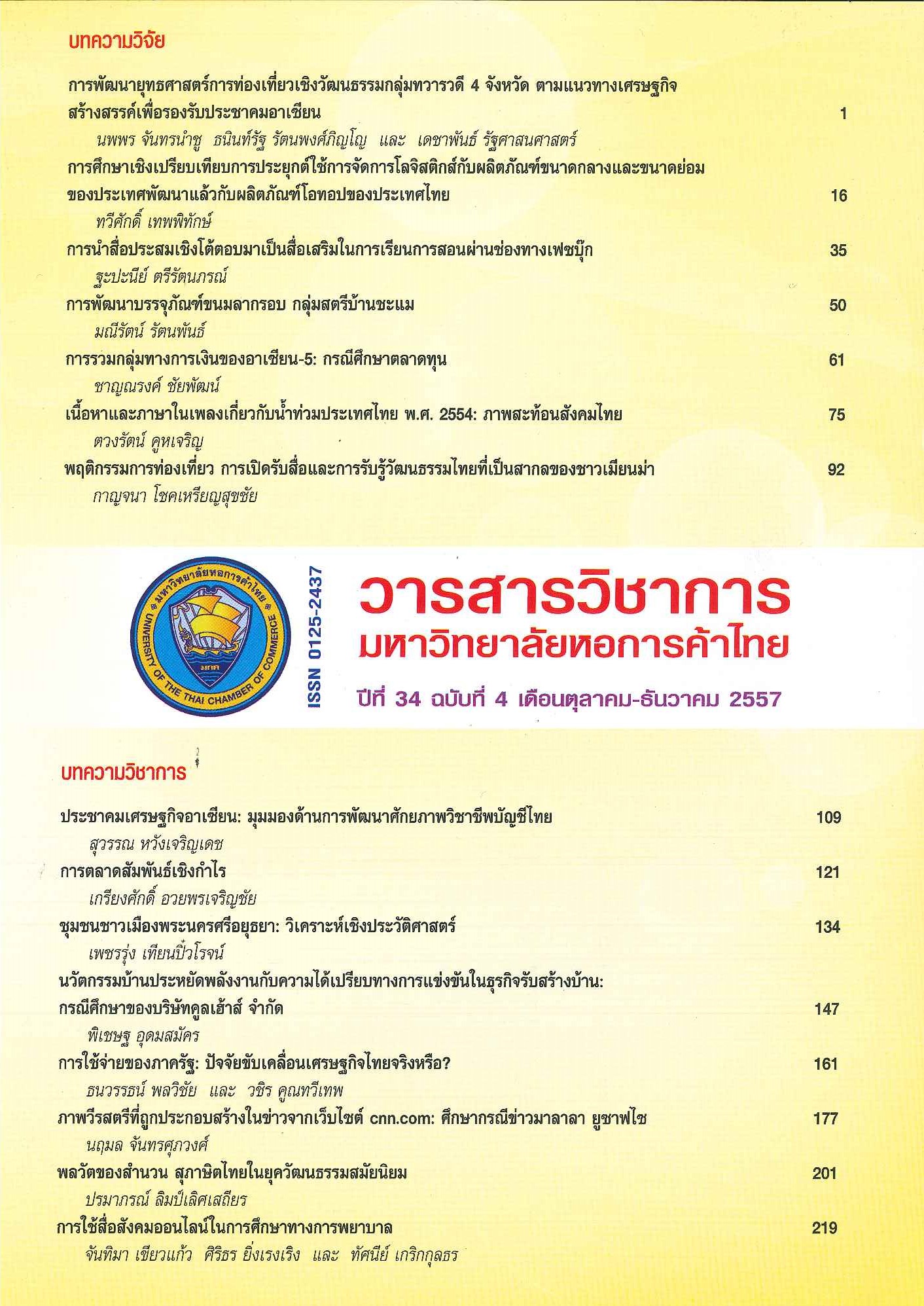Using Interactive Multimedia as a Learning Supplement via Facebook
Main Article Content
Abstract
Nowadays multimedia, one of the electronic media, is very popular around the world. It includes text with at least one of the following: sound, video, graphics, or animation. They are standard parts of most computer applications, web-based applications and stand-alone apps. They are very useful in many aspects, such as business, entertainment and education. The favorite channel for multimedia is the Internet. Synchronously, an Internet service that is now the most popular among students is Facebook. We think that if teachers could persuade students to spend their time on Facebook for academic learning, it would help them get better results from their learning. This article proposes a way to introduce interactive educational supplemental multimedia via Facebook after a class of Fundamental of Information Technology. The multimedia consists of 7 lessons. Each lesson takes approximately 6-7 minutes. The researcher posted multimedia after students had finished the lesson. The results derived from observation, a questionnaire and interviews. It was found that most students did not like to download educational media when they used Facebook. They preferred to communicate a short conversation or post some pictures rather than to download educational media and review the lesson. They stated that the education media should be concise and relevant to their needs. It was concluded that media should be posted on M-Learning or LMS (Learning Management System) rather than on Facebook.
Article Details

This work is licensed under a Creative Commons Attribution-NonCommercial-NoDerivatives 4.0 International License.
ลิขสิทธิ์ของบทความ
ผลงานที่ได้รับการตีพิมพ์ถือเป็นลิขสิทธิ์ของมหาวิทยาลัยหอการค้าไทย ห้ามมิให้นำเนื้อหา ทัศนะ หรือข้อคิดเห็นใด ๆ ของผลงานไปทำซ้ำ ดัดแปลง หรือเผยแพร่ ไม่ว่าทั้งหมดหรือบางส่วนโดยไม่ได้รับอนุญาตเป็นลายลักษณ์อักษรจากมหาวิทยาลัยหอการค้าไทยก่อน
References
Cheung, C. M. K., Chiu, P.-Y., and Lee, M. K. O. 2010. “Online Social Networks: Why do Students Use Facebook?” Computers in Human Behavior 27,4: 1337-1343.
Cheung, C. M. K., and Lee, M. K. O. 2010. “A Theoretical Model of Intentional Social Action in Online Social Networks”. Decision Support Systems 49,1: 24-30.
Chiu, C.-M., Hsu, M.-H., and Wang, E. T. G. 2006. “Understanding Knowledge Sharing in Virtual Communities: An Integration of Social Capital and Social Cognitive Theories”. Decision Support Systems 42,3: 1872-1888.
Chiu, C.M., et al. 2011. “Understanding Knowledge Sharing in Virtual Communities: An Integration of Expectancy Disconfirmation and Justice Theories”. Online Information Review 35,1: 134-153.
E- learning Manual for RMUTL [Online]. 2013. Available: https://elearning.rmutl.ac.th/main/file.php/1/manual_e_Learning_teacher.pdf (in Thai).
คู่มือการใช้งาน e-learning สำหรับอาจารย์ มหาวิทยาลัยเทคโนโลยีราชมงคล ล้านนา [ออนไลน์]. 2556. เข้าถึงจาก: https://elearning.rmutl.ac.th/main/file.php/1/manual_e_Learning_
teacher.pdf
Lin, K.-Y., and Lu, H.-P. 2011. “Why People Use Social Networking Sites: An Empirical Study Integrating Network Externalities and Motivation Theory”. Computers in Human Behavior 27,3: 1152-1161.
Nosko, A., Wood, E., and Molema, S. 2010. “All About me: Disclosure in Online Social Networking Profiles: The Case of FACEBOOK”. Comput¬ers in Human Behavior 26,3: 406-418.
Pavlov, I.I. 1927. Conditioned Reflexes. London: Oxford University Press.
Ross, C., et al. 2009. “Personality and Motivations Associated with Facebook Use”. Computers in Human Behavior 25, 2: 578-586.
Skinner, B. F. 1938. The Behavior of Organisms. New York: Appleton-Century-Crofts.
Social Media Statistics . [Online]. 2013. Available: https://www.socialbaker.com
Sukvilai, Areewan. and Kamewong, Vilailuk. 2011. “The Development and Evaluation of CAI for Learning the Topic of Variable and Operation in an Introduction to Object Oriented Programming”. University of the Thai Chamber of Commerce Journal 30, 2: 47-59 (in Thai).
อารีวัลย์ สุขวิลัย และ วิไลลักษณ์ เขมวงศ์. 2553. “การพัฒนาและศึกษาผลการใช้บทเรียนคอมพิวเตอร์ช่วยสอนวิชา โปรแกรมเชิงอ็อบเจกต์เบื้องต้น เรื่องตัวแปรและการดำเนินการ”.วารสารวิชาการ มหาวิทยาลัยหอการค้าไทย 30, 2: 47-59.
Thailand. Department of Curriculum and Instruction Development. 2001. Multimedia for Education. Bangkok: The Teacher Council of Thailand. (in Thai).
กรมวิชาการ. 2544. ความรู้เกี่ยวกับสื่อ มัลติมีเดียเพื่อการศึกษา. กรุงเทพมหานคร: คุรุสภา.
Treeratanaporn, Tapanee. 2012. “Design of the Usability Measurement Framework for Interactive Educational Multimedia”. In the Proceedings of the 4th Walailak Research Conference, pp. 183. Nakorn Sri Thammarat: Walailak University. (in Thai).
ฐะปะนีย์ ตรีรัตนภรณ์. 2555. “กรอบการทำงานในการวัด Usability สำหรับสื่อประสมเพื่อการเรียนการสอนเชิงโต้ตอบได้”.ในการประชุมวิชาการ วลัยลักษณ์วิจัย ครั้งที่ 4, หน้า 183.นครศรีธรรมราช: มหาวิทยาลัยวลัยลักษณ์.


